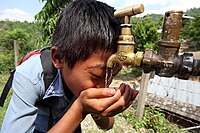
Photo from wikipedia
Abstract Study Region Part of the Lake Tana sub-basin of the Blue Nile, Ethiopia Study focus This study is aimed to identify and locate the groundwater potential zones of Megech… Click to show full abstract
Abstract Study Region Part of the Lake Tana sub-basin of the Blue Nile, Ethiopia Study focus This study is aimed to identify and locate the groundwater potential zones of Megech watershed using geographic information system (GIS) and remote sensing. Lithology, lineament density, slope, geomorphology, soil, land use and land cover, rainfall, drainage density and elevation were used as proxy data to map the groundwater potential zones of the watershed. Weights were assigned for each thematic layer and thematic layer classes using the PriEsT Analytical Hierarchy Process (AHP) tool. Suitably ArcGIS overlay analysis was conducted to obtain the groundwater potential map. Geology, lineament density, slope and geomorphology were found to be the dominant and sensitive factors for groundwater zoning as portrayed in the map removal analysis. New hydrological insights for the region Three groundwater potential zones were identified in the study area namely low, moderate and high. These groundwater potential zones were compared with an independent set of groundwater inventory data to validate the results. The validation analysis showed 78.5 % agreement between the groundwater inventory data and the qualitative results. Use of proxy data can serve as a credible source of information for groundwater potential zoning and could greatly help in the groundwater development and management of a region.
Journal Title: Journal of Hydrology: Regional Studies
Year Published: 2020
Link to full text (if available)
Share on Social Media: Sign Up to like & get
recommendations!